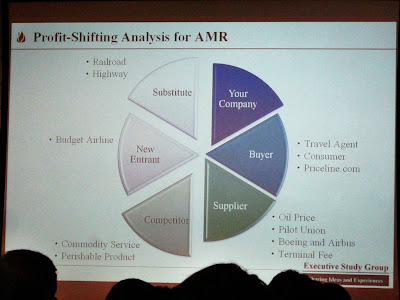The Topic of March 2012 seminar entitled “How to Maintain Profitability by Avoiding Profit-Shifting”, which organized by An Executive Study Group under the Chinese University of Hong Kong (CUHK) and the Hong Kong Science and Technology Parks Corp (HKSTPC) on 2 March 2012.

Dr. Mark Lee (DBA, CUHK) presented the content including “Understand Drivers of Industry Profitability”, “Shifting to Buyer”, “Shifting to Supplier”, “Shifting to New Entrant”, “Shifting to Competitor”, “Shifting to Subsitute” and “Group Discussion”.
In the beginning, Dr. Lee introduced the traditional profit formula (Profit = Revenue - Cost).

Then he quoted Prof. Michael Porter statement "Strategy can be viewed as:
1. building defenses against the competitive forces or
2. finding a position in the industry where the forces are weakest.
Dr. Lee asked us to guess which industries had higher return on investment.

Dr. Lee quoted Prof. Michael Porter statement "Industry structure drives competition and profitability, not whether an industry is emerging or mature, high tech or low tech, regulated or unregulated. The following pie chart showed invisible-hands sharing your profit. The case was profit-shifting for American Airlines (AMR).

Shifting to Buyer
If your product only sold to large retailer (e.g. Best Buy, Home Depot), your bargain power would be decrease. In order to avoid shifting profit to buyer, one of Hong Kong case was shared. P&G in Hong Kong promoted its brand to empower SME drug store, indicating that it did not only relie on large/chain store such as Park'N Shop and Wellcome.

Then Dr. Lee explained some strategies against "Buyer" to be considered:
1) Purchase Volume
2) Level of Standardization (Hard to differentiate)
3) Switching Cost
4) Backward Integration Possibility
5) Fraction of its Cost Structure
6) Buyer's Earning Performance
7) Impact on Quality
8) Impact on Performance
9) Influence Downstream Customers' Decision

Shifting to Supplier
Don't let your supplier shared all your profit. Dr. Lee introduced some strategies against "Supplier" below.
1) Choice Variety of Suppliers
2) Attention of Suppliers
3) Switching Cost
4) Product Differentiation
5)Entry Barrier

Shifting to New Entrant
Dr. Lee introduced some strategies against "New Entrant" as follows.
1) Supply-side Economies of Scale
2) Demand-side Benefits of Scale (e.g. Facebook)
3) Customer Switching Costs (e.g. SAP and Oracle ERP)
4) High Capital Requirements (e.g. Intel's research capability)
5) Incumbency Advantages
6) Unequal Access to Distribution Channels
7) Restrictive Government Policy (e.g. CLP)
8) Expected Retaliation (e.g. Apple Daily Retailing vs Park'N Shop and Wellcome)

Shifting to Competitor
Dr. Lee quoted Prof. Michael Porter that rivalry was especially destructive to profitability. The competition was intensified when industry matured and growth slow or industry convention emerged technology diffused and consumer taste converged.

Shifting to Substitute
Dr. Lee said there were some strategies against Substitute below.
1) Easy to Overlook (e.g. Fathers Day gift: neckties vs power tools)
2) Price-Performance Trade-off (e.g. Long distance vs Skype)
3) Switching Cost
He used BYD as example to explain substitute that lower-performance nickel-cadmium batteries was used to enlarge the market to substitute Japanese companies' lithium-ion cells. (Cost cut from US$42 to US$12).

Finally, Dr. Lee concluded to make a better decision based on profit-shifting for maximizing your profit share.

At the end of the seminar, we had an exercise to find out two of the least profitable industry and two of the most profitable industry from 10 industries.
Two of the least profitable industries were "Book Publishing 圖書出版 (13.4%)" and "Hotels 酒店 (10.4%)"; two of the most profitable industries were "Perfume, Cosmetics, Toiletries 香水,化妝品,盥洗用品 (28.6%)" and "Security Brokers and Dealers 證券經紀及經銷商 (40.9%)".
Reference:
The Centre for Logistics Technologies and Supply Chain Optimization, CUHK: http://www.logitsco.cuhk.edu.hk/
HKSTP - www.hkstp.org
Executive Study Group - https://sites.google.com/site/executivestudygroup/

沒有留言:
發佈留言